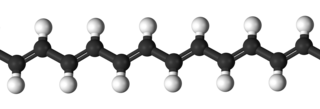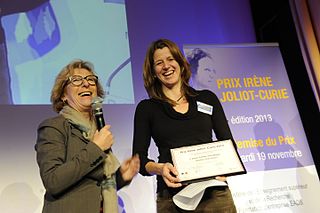
The French National Centre for Scientific Research is the French state research organisation and is the largest fundamental science agency in Europe.

Jean Baptiste Perrin was a French physicist who, in his studies of the Brownian motion of minute particles suspended in liquids, verified Albert Einstein's explanation of this phenomenon and thereby confirmed the atomic nature of matter. For this achievement he was honoured with the Nobel Prize in Physics in 1926.

Polyelectrolytes are polymers whose repeating units bear an electrolyte group. Polycations and polyanions are polyelectrolytes. These groups dissociate in aqueous solutions (water), making the polymers charged. Polyelectrolyte properties are thus similar to both electrolytes (salts) and polymers and are sometimes called polysalts. Like salts, their solutions are electrically conductive. Like polymers, their solutions are often viscous. Charged molecular chains, commonly present in soft matter systems, play a fundamental role in determining structure, stability and the interactions of various molecular assemblies. Theoretical approaches to describe their statistical properties differ profoundly from those of their electrically neutral counterparts, while technological and industrial fields exploit their unique properties. Many biological molecules are polyelectrolytes. For instance, polypeptides, glycosaminoglycans, and DNA are polyelectrolytes. Both natural and synthetic polyelectrolytes are used in a variety of industries.

Polymer science or macromolecular science is a subfield of materials science concerned with polymers, primarily synthetic polymers such as plastics and elastomers. The field of polymer science includes researchers in multiple disciplines including chemistry, physics, and engineering.

Krzysztof "Kris" Matyjaszewski is a Polish-American chemist. He is the J.C. Warner Professor of the Natural Sciences at the Carnegie Mellon University Matyjaszewski is best known for the discovery of atom transfer radical polymerization (ATRP), a novel method of polymer synthesis that has revolutionized the way macromolecules are made.
Layer-by-layer (LbL) deposition is a thin film fabrication technique. The films are formed by depositing alternating layers of oppositely charged materials with wash steps in between. This can be accomplished by using various techniques such as immersion, spin, spray, electromagnetism, or fluidics.

Rudolf Podgornik is a physicist. His fields of research are: physics of soft matter, physics of Coulomb fluids, physics of macromolecular interactions, Lifshitz theory of Casimir - van der Waals dispersion interaction, Casimir effect, physics of membranes, polymers and polyelectrolytes and physics of DNA, RNA and viruses.
Ludwik Leibler, born in 1952 is a Polish-born French physicist. He is Professor of École supérieure de physique et de chimie industrielles de la ville de Paris and member of the French Academy of Sciences and National Academy of Engineering.
The A.N. Nesmeyanov Institute of Organoelement Compounds of Russian Academy of Sciences was founded in 1954 by a prominent scientist, the President of the USSR Academy of Sciences, academician A. N. Nesmeyanov (1899–1980), who was a "father" of the modern chemistry of organoelement and organometallic compounds. He headed the Institute for 26 years. Major directions of research of the Institute are the following: Laboratories of Organoelement Profile, Laboratories of Polymer Profile, and Laboratories of Physical Profile.
Charles Louis Sadron, was a French physicist who specialized in the study of biological macromolecules.
The Hubert Curien Pluridisciplinary Institute is a joint research unit of the French Centre national de la recherche scientifique (CNRS) and of the University of Strasbourg. It was formed by the voluntary association of three research laboratories at the University of Strasbourg.

Matthew V. Tirrell is an American chemical engineer. In 2011 he became the founding Pritzker Director and dean of the Institute for Molecular Engineering (IME) at the University of Chicago, in addition to serving as senior scientist at Argonne National Laboratory. Tirrell's research specializes in the manipulation and measurement of polymer surface properties, polyelectrolyte complexation, and biomedical nanoparticles.

Gero Decher is a German chemist and Distinguished Professor at the Faculty of Chemistry of University of Strasbourg. He is best known for his seminal role in the development of polyelectrolyte multilayers, which is today known as “layer-by-layer (LbL) assembly”, a simple yet powerful nanofabrication method that has enabled the development of entirely new technologies, such as biocompatible coatings on medical devices, ultrastrong nanocomposites, neural interfaces, charge-storage devices, gas separation, fire retardants, and gene delivery platforms. According to CNRS International Magazine, Decher's work has “sparked a small revolution in materials science”. Layer-by-layer assembly is now an established part of the nanobiotechnology curriculum.
Anne Hiltner was an American polymer scientist who founded the Center for Applied Polymer Research (CAPRI) and was later instrumental in the founding of the Center for Layer Polymeric Systems (CLiPS), a National Science Foundation Science and Technology Center at Case Western Reserve University. She served as Director of the Center for Layered Polymeric Systems from its founding in 2006 until her death in 2010.

Wiebke Drenckhan, born 6 April 1977 in Bad Belzig, is a German physicist. She is a CNRS research director at the Institut Charles Sadron, where she investigates the physics and physical chemistry of liquid and solid foams and emulsions. She also works as illustrator for scientific journals and popular science books and she collaborates regularly with artists and designers.

Lenka Zdeborová is a Czech physicist and computer scientist who applies methods from statistical physics to machine learning and constraint satisfaction problems. She is a professor of physics and computer science and communication systems at EPFL.

The Strasbourg Institute of Material Physics and Chemistry is a joint research unit between the French National Center for Scientific Research (CNRS) and the University of Strasbourg. It was founded in 1987 and is located in the district of Cronenbourg in Strasbourg, France.
Interpolymer complexes (IPC) are the products of non-covalent interactions between complementary unlike macromolecules in solutions. There are foiur types of these complexes:

The French group for the study of polymers and their application, also called more simply French polymer group (GFP) is a French nonprofit organization and learned society, which aims to promote polymer chemistry, physics, and material science in French industry and institutes of higher learning.
Hans-Wolfgang Spiess, also Hans Wolfgang Spiess, is a German polymer chemist who specializes in the Nuclear magnetic resonance spectroscopy of macromolecules. He was director of the Max Planck Institute for Polymer Research in Mainz until his retirement in 2012.












